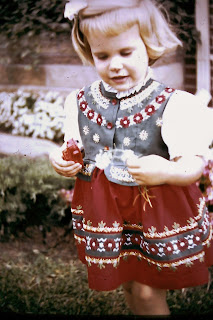.jpg) |
| Susan and Bob in Röt, Schwartzwald (2006) |
 |
| With German family |
.jpg) |
| Ilse and Susan |
.jpg) |
| Susan and Kathy |
Once upon a time in 1831 Friedrich Diercks, also known by his alias Johann Friedrich Ernst, a professional gardener from the Grand Duchy of Oldenburg in northwestern Germany, immigrated to America planning to settle in Missouri. Upon arriving in New Orleans, Friedrich heard tales of large land grants available to Europeans in Stephen Austin's colony in Texas. In 1831, Ernst applied for and received a grant of more than 4,000 acres northwest of Austin, Texas.
He thought this was something to share with other Germans in the Fatherland. Friedrich's "dominant personality" and "America letters" helped start the "chain migration" to Texas. In his lengthy "America letters" to friends in Germany, "he described a land with a winterless climate like that of Sicily. It had abundant game and fish, was fertile and rich, and awaited the impress of German labor to make it produce abundantly. Taxes were virtually nil, and large tracts of land were available for only a surveyor's fee; hunting and fishing required no licenses. Texas was an earthly paradise." Who wouldn't want land in a place as inviting as he made it sound?
Starting in the 1830s Germans immigrated to Texas through the port at Galveston and spread across south central Texas from Galveston to Houston and west as far as Kerrville, Hondo and Mason. Just as they had lived in small communities in Germany, the new settlers formed small communities in Texas. And some of their neighbors in the Fatherland, were now neighbors here.
"The German settlers who immigrated to Texas...were solid middle-class peasants. They were land-owning families, artisans, and, in a few cases, university educated professional people and intellectuals. The majority were farmers with a modest experience in trade. The Germans were ambitious farmers and artisans who believed their futures were cramped by the social and economic system at home. They were not poverty-stricken and oppressed. Indeed, they were able to afford the substantial cash investment required in overseas migration."
"Chain migration continued through the 1850s but stopped with the Union blockade of Confederate ports." During the 1850s, German-born persons in Texas more than doubled increasing the German population to more than 20,000. After the civil war ended, once again ships loaded with German immigrants debarked at the Galveston wharves. "From 1865 to the early 1890s more Germans arrived in Texas than in the 30 years before the war."
After settling mostly in the Hill Country and South Central Texas, Germans also settled elsewhere in Texas. The people were diverse: intellectuals, farmers, Protestants, Catholics, Jews and atheists, abolitionists and slaveowners, townsfolk, frugal, honest folk and ax murderers. Most came seeking economic opportunities. Some dissident intellectuals fled the 1848 revolutions and sought political freedom.
Another web site, USAtourist.com, gives a more detailed history of New Braunfels, the oldest German town, and Fredericksburg, the largest German town.
New Braunfels
Prince Carl of Solms Braunfels established New Braunfels in 1845. "It began in 1842 when a group of noblemen met at a village along the Rhine River and formed the Mainzer Adelsverein, better know as the Society for the Protection of German Immigrants in Texas. They planned to purchase large tracts of inexpensive land and to create towns for settlement of German immigrants. In 1844, the group sent Prince Carl of Braunfels to the new lands as their first Commissioner General. He managed to establish an initial colony at New Braunfels just north of San Antonio, but soon became the victim of unscrupulous scoundrels that [sic] sold him worthless land grants. His lack of good business judgment left the Adelsverein nearly bankrupt."
Fredericksburg
"In 1845, the Adelsverein dispatched an able administrator Baron Ottfried Hans von Meusebach to Texas. He quickly straightened out the financial affairs, purchased land in the Hill Country along the Pedernales River 80 miles northwest of New Braunfels and laid out a new town that he named Fredericksburg. By 1847 it became apparent that the fierce Comanche Indians in the area were unwilling to relinquish their lands to this new group of foreign intruders.
"In January of 1847, Baron von Meusebach, along with an interpreter and a small band of men, rode to the main camp of the Comanche along the Saba River. He negotiated a treaty with the Comanche chiefs that allowed the German colonists to live in peace at Fredericksburg in exchange for several thousand dollars worth of gifts. It is generally believed that this is the only treaty between native Indians and European colonists that has never been broken."
And that, my friends, is the history of German settlement in Texas. You can read more detail at the sites mentioned above and many other online sites, if you're so inclined.
 |
| Here I am at three years old in Michigan. |
Auf wiedersehen.
Travel Bug out.